Sunflower is an annual plant, and it belongs to the family Asteraceae or Compositae. It is long and, of course, with creeping or tuberous roots and large, shiny leaves. The Sunflower is an annual plant belonging to the genus Helianthus. Fundamental processes that will help increase Sunflower production. Let’s check the 25 steps to boost sunflower yield below.
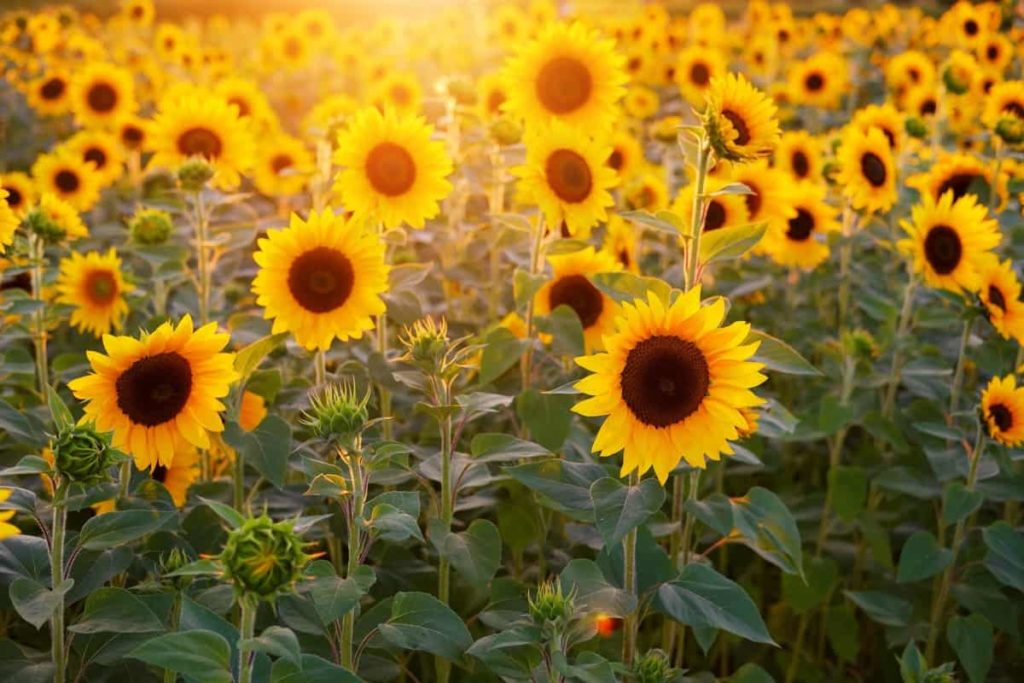
Key factors affecting Sunflower production
- Climate and place of sowing and planting
- Availability of irrigation
- Fertilization
- Protection from Pests, Weeds, and Diseases
- Increasing Technology
- Sowing with quality seeds
- Correct selection of Sunflower varieties
- Other important factors
Top 25 steps to boost Sunflower yield
Step 1: Soil requirement for Sunflower production
Sunflowers prefer alkaline soils (pH 6.0 to 7.5) to some extent, and they are very high feeders, so make sure you plant them in nutritious soil.
Step 2: Effect of sunlight on plant growth
Sunflowers prefer direct sunlight, i.e., 6-8 hours per day. They bloom well during long, hot summers. In general, sunlight provides plants with the energy to convert carbon dioxide and water into carbohydrates and oxygen. Carbohydrates produced by photosynthesis enhance plant and reproductive growth and crop biomass.
Step 3:Know the seed yield potential
Choose the seed with the highest potential for planting. Different types of Sunflowers have different amounts of seeds per unit volume. To get the highest yield of Sunflower in your conditions, you should choose the varieties that give the highest yield in your needs. The fact is that different types of Sunflowers will produce other things in the same field. Seeds should be of one size and fraction and have good germination. The same variety can make different products in additional years and with extra care. One type can show the highest yield; the other can give the highest yield in another year.
In case you miss this: Sunflower Questions and Answers – Planting FAQs
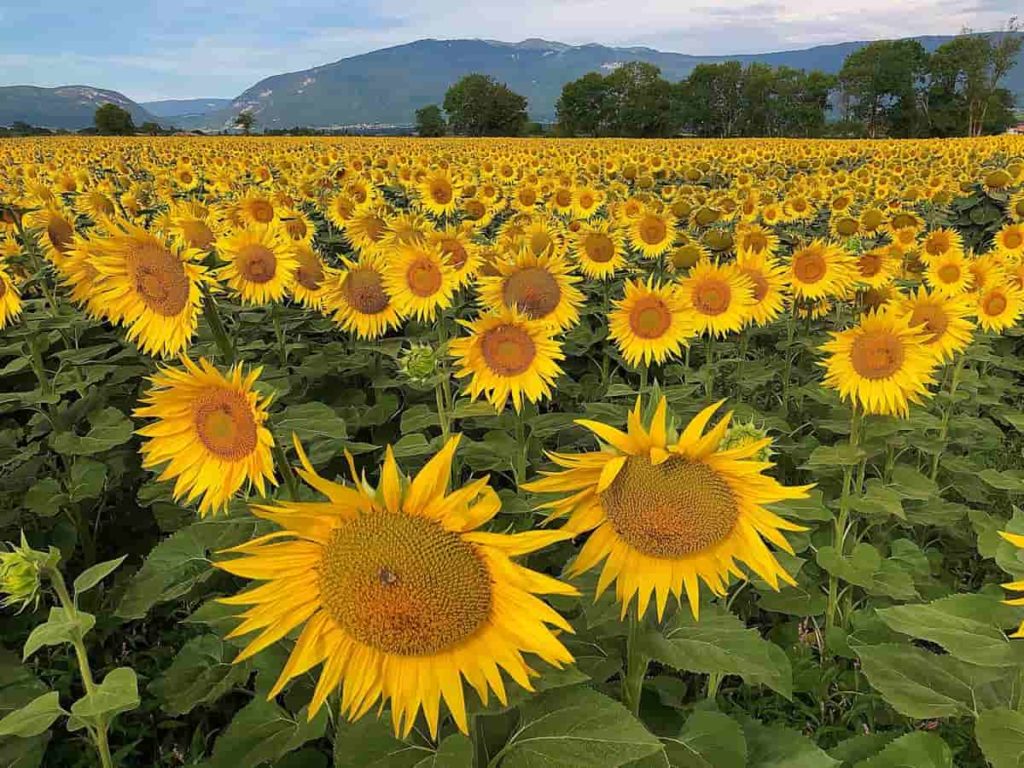
Step 4: Choose the right hybrid
It is essential to choose the right hybrid that suits your location because the quality of the product depends on that choice. And ultimately, your income will depend on the quantity and quality of Sunflower seeds and oil. Some Sunflower hybrids such as PAC-36, PAC-1091, and PAC-8699 are high-yielding varieties. The government has recognized these hybrids.
Step 5:Perform timely sowing
If you select a long-term hybrid variety, you should sow earlier in the season, while short-term sowing can be done later. Seeds can be successfully sown from January to June for flowering in the summer and rainy seasons. You should avoid constantly growing Sunflower crops. Intercropping is good. Otherwise, you can remove soil and increase the incidence of pests and diseases.
Step 6: Early planting will increase crop yield
the best strategy is to start growing as soon as the soil is ready.
Step 7: Sunflower seed treatment to obtain higher yields
Before planting Sunflowers, it is essential to treat the seeds and plants to protect them from diseases and pests. It will help get healthy plants and ensure their even distribution in the field for higher yields.
Plant density varies depending on the moisture supply, and by the beginning of the harvest season, it should be;
- In humid forest plains and adjoining plains – 40-50 thousand plants per 1 hectare
- In semi-arid plains – 35- 45,000 plants per 1 hectare.
When cultivating early ripening Sunflower hybrids, increasing their density by 10-15%, but not more than 55-60 thousand per hectare, is recommended. The higher the Sunflower seed rate, the shorter the row spacing.
Step 8: Consider using high-quality seed
Using hybrid seeds that tend to be naturally strong, fast-growing, and highly efficient. Good Sunflower seeds contain about 50-55% oil.
Step 9: Performing field scouting
Scouting allows you to assess soil conditions, detect the spread of weeds and diseases, and check that crops are growing healthy.
In case you miss this: Growing Sunflower In Pots – From Seed At Home
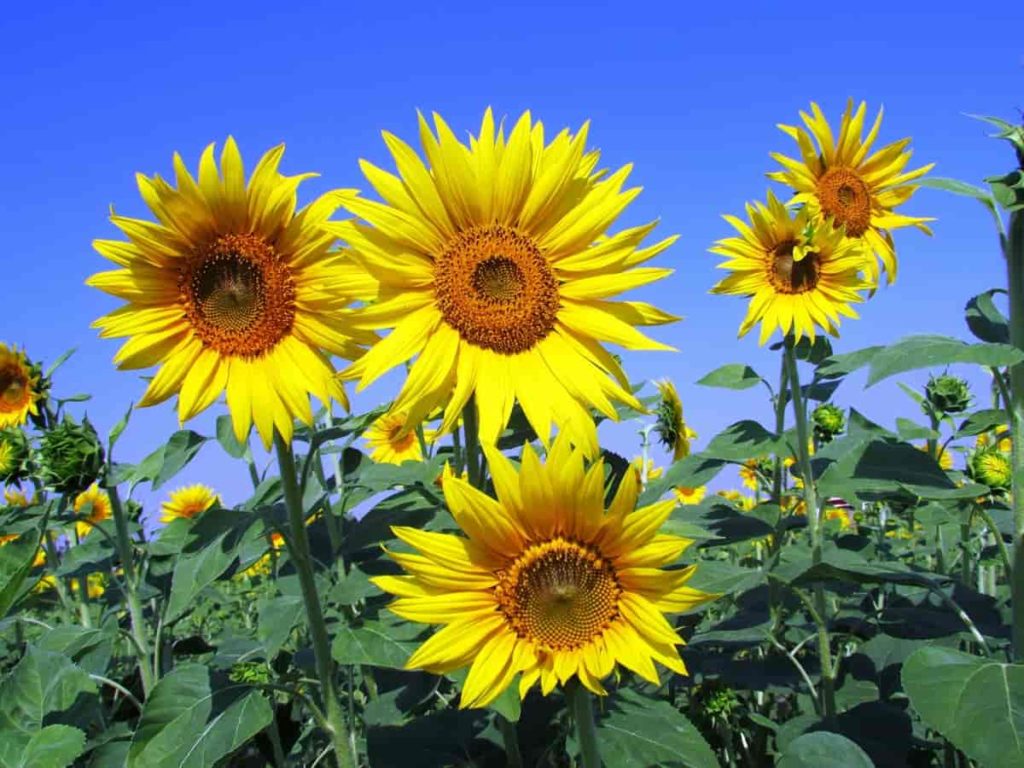
Step 10: Ways to improve seed setting in Sunflower
- Initially, hand pollination with a white cloth after flower opening for 8 to 10 days between 8-11 AM, increases seed yield by 20-25%.
- Spray% 0.5% borax on the Star Bud stage increases seed production and quality.
- To increase pollination, keep five beehives per hectare (10% flowering) to increase the pollination yield by 10-15%.
Step 11: Providing proper fertilization will improve crop yield
- If you want to increase income by cultivating Sunflower, you must increase the yield. You should apply the recommended dose of fertilizer at the appropriate time.
- The essential nutrients for Sunflower crops are potash, phosphorus, boron, and sulfur.
- NPK / hectare is required 40: 40: 0 for modern variety. For other types, it is 60: 60: 0. NPK helps increase the weight of grains and the amount of oil in seeds.
- Apply 60 kg/hectare of phosphorus SSP (Single Super Phosphate) during sowing. It increases seed and oil production.
- Fertilization helps seeds provide essential nutrients, facilitates plant growth, and protects against pests and diseases, resulting in higher yields.
- Nitrogen is usually the most common limiting factor for production. Nitrogen fertilizer reduces seed oil percentage, alters amino acid balance, and increases plant leaf area. Fertilizer rates have increased yields by 175 pounds per acre, but rates are much lower than generally recommended.
Step 12: Growing Habit
Sunflower is an annual, erect, broad-leaved plant whose roots spread with solid roots. The stems are round at the season beginning, angular and woody at the end, and usually without branches. Generally, the Sunflower’s head is not a single flower but is made up of 1,000 to 2,000 individual flowers attached to a typical reception. The flowers around the frame are ligulate ray flowers without stamens or pistils; the rest of the flowers are perfect flowers.
Anthesis (pollen shedding) starts from the circle and goes to the center of the head. Because many species of Sunflower have self-made incompatibility, the movement of pollen between plants by insects is essential, and bee colonies have generally increased yield.
Step 13: Crop rotation for increasing crop yields
Sunflowers are usually grown in rotation with Maize or Sorghum and benefit from the dense mulch of these crops. Sclerotinia stem rot fungus can cause sudden leaf wilting, stem cankers, and root or head rot. Crop rotation can reduce the chances of this disease. Crop rotation with Groundnut / Sorghum / Pigeon Pea is helpful to control more diseases. If sunflower is crop rotation with Maize, the weeds can be controlled more effectively as the grass and the broadleaf herbicides can be used for the continuous success of each other.
Step 14: Tips to grow Sunflowers bigger
If you have planted Sunflower plants that begin to bloom before they are barely taller than you, there are several possible causes like root damage during transplanting, early cold snap, or a nutrient deficiency. Two biological factors explain the evolution of large Sunflowers and why they occur in more arid environments. The pollinator’s selection is thought to have Sunflower’s size increased in a drier atmosphere.
In case you miss this: Top 20 Garden Plants That Attract Pollinators to Your Garden
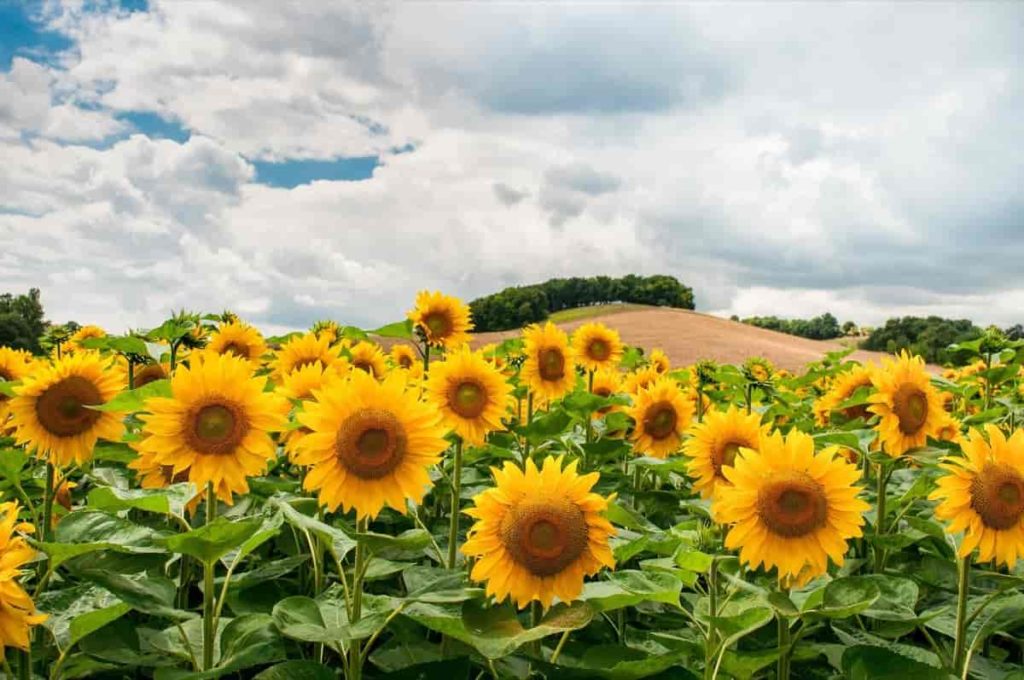
In drier climates, there are usually fewer pollinators. As a result, more and more Sunflower pollen is attracted. To do this, they had to increase the shape of their flower traits as they had to increase the size of their display. Another biological factor that could explain the evolution of large Sunflowers in dry environments is that florivory and disease pressure are favorable for small flowers in habitats with a high moisture supply.
Step 15: Weed control will increase Sunflower yield
Sunflower yield is reduced but rarely depleted by weeds that compete with Sunflower for nutrients, moisture, and occasional light. Sunflower is a competitor to weeds, especially for light, but it does not cover the earth quickly enough to prevent weed formation. Therefore, controlling weeds in the early season is essential for good production. Annual weeds have been the main focus of herbal research. Perennial weeds can also cause problems, but they are not usually specific to Sunflowers.
Successful weed control must include a combination of cultural and chemical methods. Sunflower plants are cultivated and harvested to control weeds, and more than 2/3 are treated with herbicides. Cultivation after emergence with a coil spring hero, spike tooth harrow, or rotary hoe is possible when the Sunflower is at the stage of four to six leaves (beyond the cotyledon), preferably in the dry afternoon when the plants are less hardy. One or two are common between row plantings less than 6 inches long. Many herbicides are currently approved for weed control in Sunflowers.
Step 16: Adequate water is essential for Sunflower growth
In arid plains with deep groundwater, irrigating Sunflowers in fall is recommended to create moisture reserves. It starts when the flower buds reach about 3 cm and ends when the plants bloom. It is also better to use irrigation installations that provide water distribution.
It keeps soil moisture above 60% of field moisture capacity during the growing season and more than 80% during increased moisture consumption or in more expected yielding crops. After starting irrigation, it should be continued every 8 to 12 days as required. Irrigation can be continued until 50% of the green leaves remain after flowering.
Step 17: Insects, pollinators, and birds affect Sunflower yield
Bees are good for Sunflower yield. Some Sunflower species will not produce the highest yields unless pollinators are present. All species will produce some sterile seeds, but varieties vary depending on the insect pollinators.
Autogamous Sunflower hybrids do not need bees for maximum production and produce the exact yield when covered with bags. The pericarp growth is average in non-automatic Sunflower species, but no ovules or meat are produced. In the cross-pollination of Sunflowers, the wind is relatively insignificant. Some older open pollen varieties set only 15 to 20 percent seed without pollinators, while many hybrids set 85 to 100 percent seed without pollen.
Insects have become a significant factor in reducing Sunflower production. Typical Sunflower insects that feed on heads include the larvae of three moths like Sunflower moth, banded Sunflower moth, and Sunflower bud moth. Sunflower midge has caused extensive damage in recent years. Sunflower Beetle, Sunflower Head Clipping Weevil, Sunflower Maggot, Wire Worm, Grasshopper, Cutworm, Sugar Beet Webworm, Ragweed Plant Bug, Woolybear, Lady Caterpillar have occasionally damaged Sunflowers.
In case you miss this: How to Keep Squirrels Out of Your Garden: Ideas, Tips, Techniques to Control Naturally
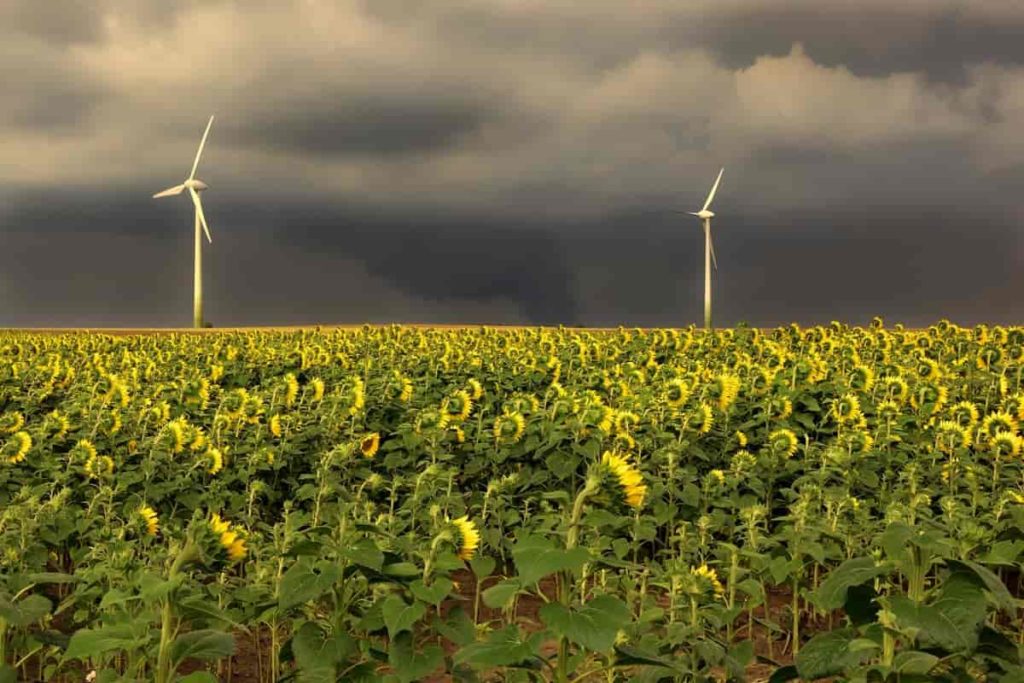
Step 18: Sunflower drooping causes and solutions
There are a few reasons for your Sunflower to die. Sunflowers can be susceptible to the following;
- Not enough nitrogen
- There is not enough space for the root system
- Need more sunshine
- Overwatering
- Overheated
- Pests and diseases
- Poor quality soil
Step 19: Natural solution to control Sunflower drop
Add one teaspoon of sugar, one tablespoon of vinegar, and lemon juice about two tablespoons to the water to keep your flowers active and healthy. It helps prevent Sunflowers from dying. Ensure your Sunflowers are not exposed to direct sunlight, cold drafts, or heat.
Step 20: Improper conditions will cause Sunflower drooping
Like other flowering plants, Sunflowers need appropriate cultural conditions to be met. If these are not met, the plant will not grow properly, and in a few days, you will see the flowers fall. Sunflower plants are incredibly susceptible to poor care, and if the right growth conditions are not met, the plant will be damaged.
Step 21: Reasons Sunflowers begin to droop or wilt
Problems such as excessive shade or poor soil conditions are the main issues for Sunflower droop. Some common causes of Sunflowers falling or withering over time include poor soil conditions or extreme frost. It would help ensure that the Sunflower is kept in moderately fertile soil. Another reason Sunflowers begin to wilt or droop over time diseases. Many different types of fungi can infect plants, and some can even cause them to die off.
Step 22: Lack of nitrogen will cause Sunflower drooping
Sunflowers need plenty of nitrogen in their soil to grow long and healthy. The amount of nitrogen in the soil will affect the size of the Sunflower, seed production, and leaf growth. Since Sunflower is a deep-rooted plant, it is advisable to add fertilizer to keep it well-fed and happy.
Nutrient balance is essential, as giving too much nitrogen to Sunflowers can reduce flowering. See if the type of Sunflower you grow is perennial or annual, and start with a low nitrogen fertilizer. You may want to fertilize the soil before planting to give your Sunflower a good start. If the nitrogen is too low or you stop fertilizing Sunflowers, their leaves may turn yellow and fall off. When the soil is deficient in nitrogen, most plants will show stunted growth and thinner stems.
Step 23: Yellow leaves in Sunflower
Yellow leaves of Sunflower often mean that your Sunflower is submerged in excess water or is dealing with poor drainage. The plant leaves may turn yellow if the plant gets too much water from rain or moisture. Yellow leaves can also indicate nitrogen deficiency.
In case you miss this: The Best Fertilizer for Tomatoes in Pots
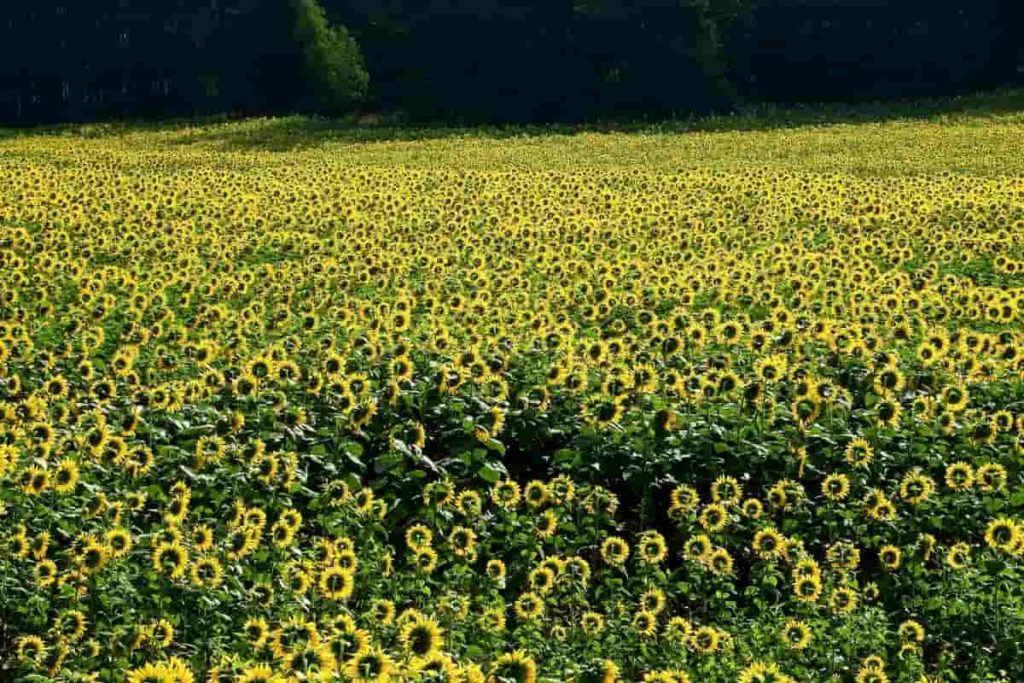
Step 24: Best varieties for Sunflower seeds
When growing Sunflowers for harvesting, it is essential to choose a suitable type. Some smaller Sunflowers do not produce as many seeds, and some larger varieties have seeds with a thicker shell and tiny seeds. Both of these varieties are not ideal.
The best varieties for harvesting Sunflower seeds include Mammoth Grey Stripe, Mammoth Russian, Titan, Giganteus, Hopi Black Dye, Paul Bunyan, Sunzilla, Royal
Step 25: Harvest is an essential factor for crop yield
Sunflower crop ripens in 90-100 days. The crop has to be harvested when the lower part of the head turns yellow, and some brackets dry out. Mature heads are cut with a sickle, and the upper part is dried by exposing it to seeds in sunlight. Cleaned seeds are thoroughly dried and stored in gunny bags.
- Gardening Techniques in Planting Vegetables
- Where to Place Indoor Plants in Your Home
- How to Grow Tomatoes Organically at Home: A Comprehensive Guide
- Organic Gardening on a Budget: Low-Cost Methods and Materials
- Gongura Seed Germination and Planting Methods
- Cabbage Seed Germination and Selection
- Broccoli Seed Germination and Selection
- Asparagus Seed Germination and Variety Selection
- Seasonal Flower Gardening: Best Practices for Spring, Summer, Fall, and Winter
- How to Grow Hibiscus from Flower
- Plantation Ideas for Home Decoration: A Beginners Guide
- Flower Garden Designs and Layouts for Beginners
- Planting and Spacing Techniques in Papaya: A Beginner’s Guide
- Growing Gold: Essential Techniques for Planting Pineapples
- How to Make Kalanchoe Plant Bushy: Home Remedies and Solutions
- 11 Reasons Why Your Gardenia is Not Blooming: Home Remedies and Solutions
- Eco Elegance: The Guide to Designing a Drought-Tolerant Landscape
- Gardening on a Slope: Strategies for Hillside Landscaping
- Nourish and Flourish: Top Organic Mulches for Thriving House Plants
- Everything You Want to Know about Indian Mogra Flower: Discover Uses and Growing
- Green Thumb Success: Expert Tips for Cultivating Greenhouse Pumpkins All Year Round
- Maximize Growth & Flavor: The Ultimate Guide to Companion Planting in Herb Gardens
- How to Control Rhododendron Problems Naturally: Home Remedies and Organic Ways to Fix Them
- Natural Magic: The Remarkable Benefits of Cinnamon for Plants
- Best Steps to Revive Dying Tulip with Natural and Organic Treatment
- 10 Reasons Why Your Angel Trumpet is Not Blooming: Remedies and Treatment
- How to Fix Periwinkle Leaf and Flower-Related Problems: Natural Remedies and Solutions
- How to Fix Zinnias Leaf and Flower Problems: Discover Natural and Home Remedies
- Organic Steps to Induce Lemon Tree Flowers: A Comprehensive Guide
- Bloom Booster: Crafting the Perfect Homemade Bougainvillea Fertilizer
- Optimizing Growth: A Guide to Applying NPK Fertilizer for Potted Plants
- 10 Best Homemade Fertilizers for Rubber Plant: DIY Recipes and Application Method
- How to Boost Female Pumpkin Flowers: Effective Steps for More Flowers and High Yields
- Transform Your Indoor Garden: Top Benefits of Pink Salt for Houseplants
- 10 Best Homemade Fertilizers for Peacock Plants (Calathea): Easy DIY Guide
- Unlock Blooms: 9 Reasons Why Your Potted Chrysanthemum is Not Blooming